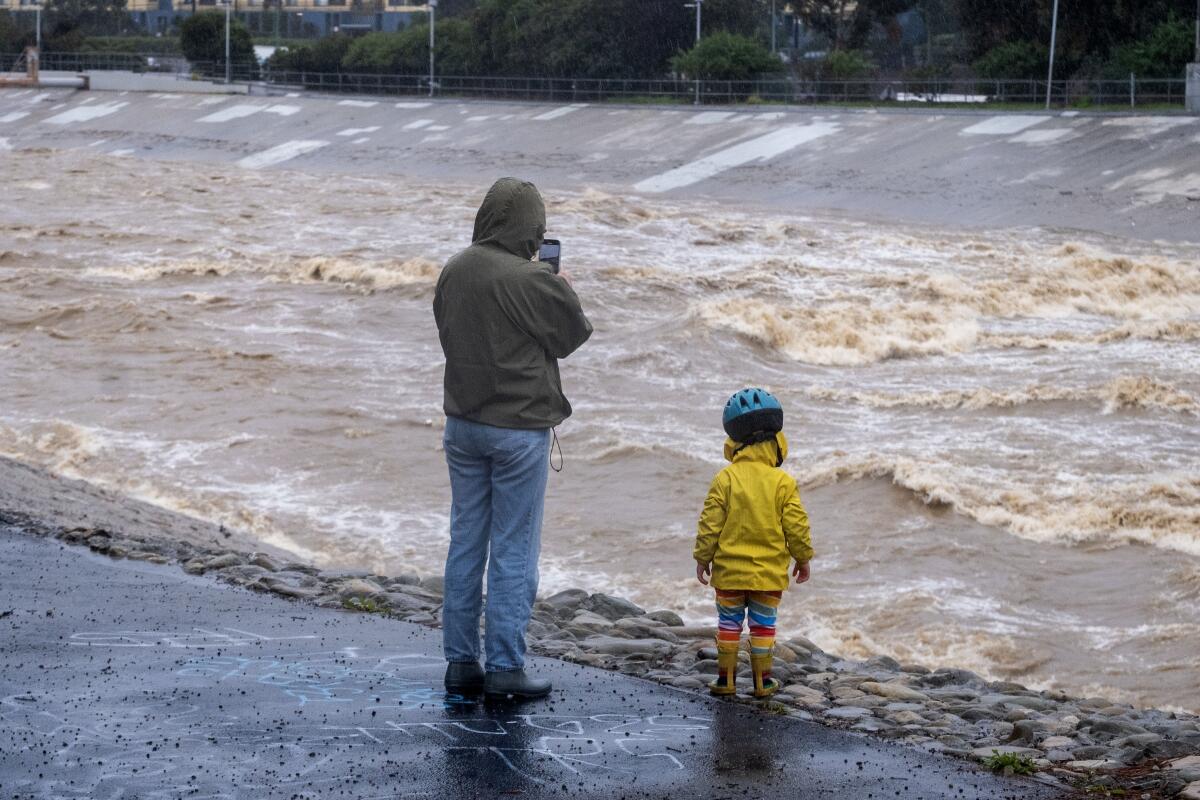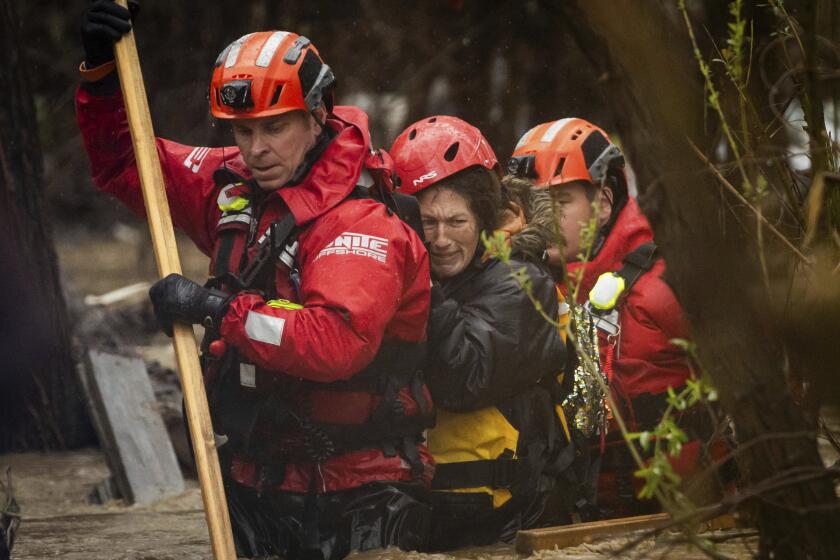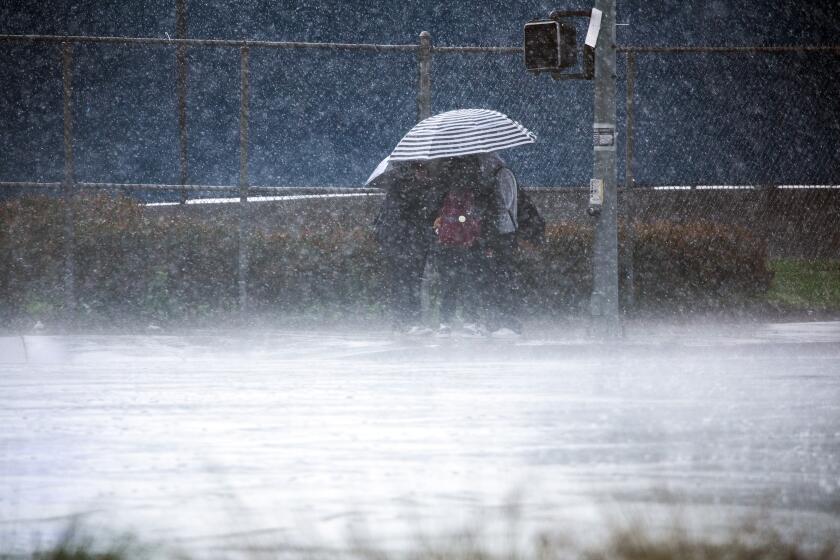LAUSD schools open amid historic storm with 4 in 10 students staying home

- Share via
Los Angeles students and school employees soldiered through a challenging, drenching Monday — with about 63% of students and about 90% of teachers and other staff making their way to campuses as the city worked through the 10th wettest day ever recorded locally.
For Southland college students, classes moved largely online.
The school system dealt with a number of power outages in the morning, and four schools lost phone service, said L.A. schools Supt. Alberto Carvalho. At midday, power still was out at Cahuenga Elementary. Only one bus broke down; on average buses were 30 minutes late to school Monday morning.
There are no plans to close campuses Tuesday, when conditions are expected to improve, even if rainy weather continues, Carvalho said.
Given the size and sprawl of the nation’s second-largest school system — about 900 campuses — Carvalho said the decision to keep campuses open was proved correct.
Other school districts reported similar experiences: mainly smaller-scale mishaps. At Long Beach Polytechnic High School, a falling tree damaged a classroom, but classes proceeded. Complete figures were not immediately available but 29% of elementary students were absent. Pasadena Unified reported near-normal attendance for staff. Glendale Unified staff absences were a little higher than normal. Among students, the absence rate was 22.4% versus 5.8% the previous Monday.
Falling trees killed at least three people in Northern California as a winter storm walloped the state. The system is slowly moving across L.A. and Orange counties.
“We have had thus far a rather successful school day. The numbers don’t lie,” Carvalho said during a news conference with L.A. Mayor Karen Bass and other officials at the city’s emergency operations center.
“I spoke with parents who extended their appreciation for the fact that we maintained our school sites open,” Carvalho said. “I spoke with a mother, single parent, who was an essential worker and nurse who had to go to work and she did not know what to do if the school was not open for her child.”
Carvalho also cited the benefits of providing food to children — about 80% of students qualify for free or reduced-price meals, which include breakfast, lunch and sometimes take-home dinners.
But the superintendent knew opinion would be divided on his move — just as it was when he closed campuses as Tropical Storm Hilary approached in August, only to have a sunny Monday unfold after a stormy weekend.
“You’re always going to make 50% of your audience happy, 50% unhappy,” Carvalho said in an interview. “We make decisions on the basis of scientific data that’s available to us, always leading with safety and security for our kids and the workforce.”
Comments from parents and staff bore out his expectations of divided opinion, leading to lively exchanges on social media forums, including Parents Supporting Teachers, whose members include thousands of L.A. parents and school district employees.
“We should have rain days available,” parent Jordin Lang Johnson said. “My kids stayed home. There was no way to safely travel to school. Our area was under flash flood emergency warning. My mom, who teaches for LAUSD, drove in dangerous conditions from West Valley to NoHo and went to work. We would have all appreciated the peace of mind from a ‘rain day.’ ”
Parent Beth Owen is from Texas and sees a familiar, manageable weather event.
“Rain happens,” she said. “It’s ok. And if you live in the hills and it’s not safe — be safe. If your drive time to school and back would take the whole day — understood. But canceling isn’t necessary.”
Her children attend school on the other side of the flooded Sepulveda Basin, making travel more challenging.
“I opted for delayed arrival,” she said. “My middle schooler complained and her friends were reporting it was miserable — but well, that’s the general consensus every day in middle school, isn’t it? Hopefully I will get her home mostly dry. My son had no complaints at all.”
“Eighth grade at my school has 40% absent,” reported Jennifer Turner, a teacher in the disrict’s east region. “There are eight leaks in the upstairs hallway.”
“My parent center is flooding. I got tiles falling,” said Paola Armienta.
Parent Eva Alvarez Pasillas said she heard about a power outage at Franklin High in Highland Park: “Good thing I kept my son home.”
“Thirty-eight rooms have leaks,” despite the heroic efforts of local staff, said Debbie Steinert, a magnet program coordinator at Sylmar High in the northeast San Fernando Valley. “I came to school with buckets today knowing that our office leaks and they would need all the containers they could find.”
But she wouldn’t have closed campuses:
“We also have to keep in mind that we are an integral part of the infrastructure of the city. ... We can’t deny the impact it has when we shut down. Our parents include workers at Caltrans, LADWP, Edison, L.A. Dept. of Transportation, Metro, food services, gas stations, fire departments, law enforcement agencies, flood control agencies, building maintenance staff, postal offices, medical facilities and many other places that I haven’t thought of. We all need those workers during this storm.”
Moreover, “too many of our kids live on the street. I am grateful that we are there to keep them warm and dry if only for a few hours.”
“Parents are making tough decisions,” said Evelyn Aleman, founder of the group Our Voice: Communities for Quality Education, whose members are mostly low-income Latino parents. “Many of our families use public transportation to get their children to school, so getting around in this storm will be hard for them. Some will keep their children home. Others may not have access to child care, so they will take their children to school. Health and safety are top of mind for everyone.”
The district’s 63% attendance rate was markedly lower than recent 92% standards. Carvalho spoke Monday after city and county officials pleaded with residents to stay off the roads and avoid unnecessary travel — but none of them took issue with his decision, which effectively put several hundred thousand students on the roads and sidewalks.
The school system has about 420,000 students and about 75,000 employees.
While keeping schools open, Carvalho also emphasized that no family or worker should undertake travel that they believed to be unsafe.
LAUSD’s early strategy, keeping schools open, is a sharp departure from the quick decision to close schools as Tropical Storm Hilary approached last August.
The attendance rate of school workers — which Carvalho said was not far off normal — was especially impressive because their homes are scattered all over L.A. County and even beyond. Students in contrast typically attend schools relatively close to where they live.
In keeping schools open, L.A. Unified was not an outlier. That was the common decision among school districts throughout the region. An exception was Santa Barbara County, where all public schools were closed for Monday. Other places with closed schools faced potential grave risk from flooding, unstable hillsides or severe winter weather, including Malibu along the coast and the campuses in the Big Bear area in the San Bernardino Mountains.
The two closed L.A. campuses faced hillside hazard issues: Topanga Elementary Charter School in Topanga and Vinedale College Preparatory Academy in Sunland. School officials directed those students — and their teachers — to nearby campuses.
Most if not all Cal State campuses moved to remote learning. UCLA and USC announced that Monday would be business as usual but many instructors at UCLA moved their classes online anyway.
Time staff writer Teresa Watanabe contributed to this report.
More to Read
Sign up for Essential California
The most important California stories and recommendations in your inbox every morning.
You may occasionally receive promotional content from the Los Angeles Times.













